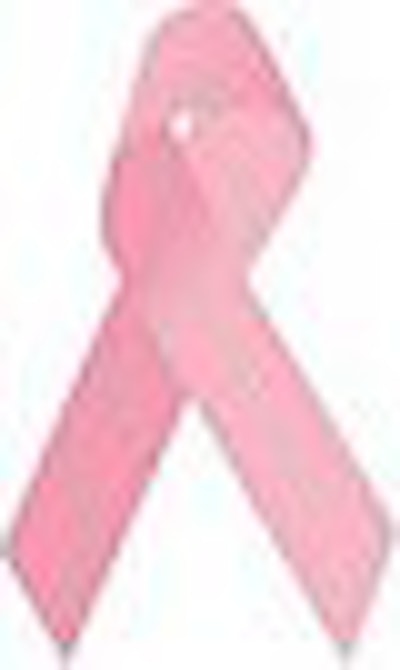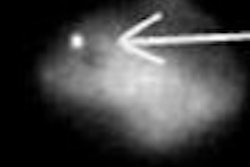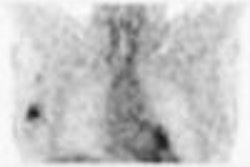
National Breast Cancer Awareness Month (NBCAM) launched more than 20 years ago, ballooning from a weeklong public service announcement into a month's worth of high-profile fund-raising events and endless merchandising opportunities (anyone need pink ribbon boxing gloves?). In addition, October 20 has been designated National Mammography Day by U.S. legislators.
The worthy goal, of course, is to raise public consciousness about breast cancer, and drive home the message that annual screening with mammography remains the best way to detect breast cancer early. Still, compliance with screening guidelines in the U.S. remains at a lackluster level. Studies have shown that many women in their 40s who are eligible for screening do not go on an annual basis, while others such as women over 60 and ethnic minorities skip out completely.
There are numerous reasons why women don't adhere to screening guidelines, and two big ones start with the letter "C" -- cancer and compression. We propose that there's another "C" reason at play: confusion. A major source for misconceptions about breast cancer and cancer screening comes courtesy of the rumor mill.
In this article, we round up some of the more common myths and misperceptions about breast cancer and cancer screening, and give them a shakedown, figuring out where they sprang from and how to handle them.
This list is by no means comprehensive. If you have heard other interesting tales from your patients, or been asked particularly creative questions, feel free to share them with us (anonymously is fine) and we'll publish them at a later date.
Paget's disease is a new kind of breast cancer
"SERIOUS - New kind of Breast Cancer - DO NOT DELETE."
So screams an e-mail about Paget's disease that has made the rounds for some time. The e-mail outlines the story of an allegedly real patient whose "rash" was diagnosed as a "fast-growing malignancy." According to the e-mail, the woman underwent several rounds of therapy before succumbing to the disease. The body of the e-mail consists of the woman's dying wish that "the message (about Paget's disease) be delivered to women everywhere."
While Paget's disease is a real and serious condition, it isn't nearly as common as the alarmist e-mail would have women believe. The Web site for the Dr. Susan Love Research Foundation in Pacific Palisades, CA, has a section on Paget's disease that addresses this particular e-mail, suggesting that "the patient described in the Internet e-mail legend undoubtedly had a deeper and more dangerous cancer at the time the Paget's disease appeared."
There is nothing "new" about this condition. "Paget's disease of the nipple is a term used for more than 100 years -- named after Sir James Paget," explained Dr. Barbara Schepps, director of the Anne C. Pappas Center for Breast Imaging at Rhode Island Hospital in Providence. "It's one of the few terms in breast cancer with historical longevity. The entity is presentation with an eczematous area of the nipple. It can be subtle or erosive. The cells seen histologically are identical with DCIS (ductal carcinoma in situ)."
Because it mimics other less onerous conditions such as a surface rash or sore, Paget's disease doesn't receive as much media attention as other breast diseases, leaving women to fend for themselves when it comes to finding more information.
E-mails such as the Paget's disease one may serve to initially inform women about the disease, but most likely do little more than scare. Perhaps the most telling element of this e-mail is its dubious origins. It's been around for at least three years, according to TruthMiners.com, yet it offers no useful information on how it came into existence, and does not ultimately name the type of advanced cancer that this patient allegedly had.
Digital mammography requires no breast compression
When an AuntMinnie.com editor made the transition from being a newspaper reporter to an imaging news editor, one of the first questions her female former co-workers asked her was: "Isn't there some kind of new mammogram that doesn't need compression?"
That was in 1999, when the buzz about digital mammography was growing. As with any new technology, the hope was that it would be bigger, better, and faster. For many women, that was synonymous with banishing compression.
"Women often ask if there's some way to find cancer that doesn't require compression -- we only wish that were the case!" said Bonnie Rush, president of Breast Imaging Specialists in San Diego, CA. "They ask if we have 'that new machine' for this purpose. Technologists are stymied by this."
"I get asked about that (mammography without compression) a lot," concurred Dr. Dixie Mills, research director of the Dr. Susan Love Research Foundation. "We often joke that mammography was invented by a guy, and that women must be working on something new."
Of course, the ensuing years have seen many of our questions about digital mammography being answered, particularly by the results of the Digital Mammographic Imaging Screening Trial (DMIST). However, one thing hasn't changed -- compression is still required.
But that won't necessarily stop women from hoping for a pressure-free breast imaging modality. "There are also other emerging modalities that may confuse women," added Rush. "They just hear the part about a tool for diagnosing breast cancer that doesn't require compression, such as ultrasound and MRI."
Speaking of which ...
Ultrasound is better than mammography for cancer detection
Breast sonography received an unexpected boost in 2001 when actress, author, and thigh mistress Suzanne Somers enthusiastically proclaimed that an ultrasound exam saved her life. More specifically, the modality spotted a malignancy that had been missed by mammography.
Somers devoted a chapter in her autobiography/self-help book, "The Sexy Years," to praising ultrasound and her surgeon, Dr. Melvin Silverstein from the University of Southern California (USC) in Los Angeles. At the time of Somers' diagnosis, Silverstein, who also serves as the director of the Harold E. and Henrietta C. Lee Breast Cancer Center, was simultaneously spearheading an effort to persuade payors to increase reimbursement for breast ultrasound and minimally invasive breast biopsy.
Of course, from a clinical viewpoint, Somers was not completely wrong -- ultrasound is valuable as an adjunct to mammography, able to distinguish solid tumors from fluid-filled cysts. The American College of Radiology Imaging Network's (ACRIN) study number 6666 is currently in the patient follow-up stage to determine if breast ultrasound can be used in a screening capacity.
But Somers' endorsement that "my life was saved because of this (ultrasound) machine" gave many women the idea that sonography was superior on its own, rather than in conjunction with mammography.
Even years later, Rush said she fields questions about ultrasound. "I tell (women) ultrasound is indeed a good tool, but not alone. It doesn't do as good a job in screening as mammography. I say its strength is that it can tell if something is solid or not, and it's helpful when something that can be felt is not seen on the mammogram."
If a celebrity has cancer, then I probably have it, too
At the time of Somer's diagnosis, society's obsession with celebrities and their lives was in its infancy. Nowadays the smallest paper cut could land a star on the cover of US magazine. When a celebrity is diagnosed with cancer, media coverage can shift into overdrive. While there is the saying that there's no such thing as bad publicity, all this attention can either have a positive outcome -- the increase in colon cancer screening because of the "Katie Couric effect," for example -- or it can cause minor mayhem.
In 2005, when 36-year-old Australian pop singer Kylie Minogue announced that she had breast cancer, the country's press corps breathlessly covered every aspect of her diagnosis, treatment, and recovery. A frequent comment in many of these articles was that Minogue's case had unleashed hordes of concerned young women on Australian breast health clinics, all demanding mammograms.
Dr. Helen Zorbas, director of Australia's National Breast Cancer Centre, diplomatically stated that Minogue's diagnosis had significantly raised awareness among young women, but cautioned that "I certainly hope her diagnosis doesn't create a lot of unnecessary fear and anxiety, because the incidence of breast cancer in young women is very, very low" (ABC News Online, May 18, 2005).
When screening is backed by such high-profile breast cancer survivors as Sheryl Crow and Melissa Etheridge, it does have palpable benefits. A study in the Journal of the National Cancer Institute found that 73% of women who were surveyed were aware of celebrity endorsements of cancer screening, and 37% said they were more likely to seek cancer screening as a result.
Unfortunately, in the case of breast cancer, these messages are not as much of an influence on women in the right age group. In Minogue's case, the demographic that needed it the least was the one that showed the greatest interest. Age is the main risk of breast cancer, and older women are less inclined to take advantage of screening opportunities (Professional Nurse, December 1999, Vol. 15:3, pp. 155-159).
Click here to fund free mammograms!
The Breast Cancer Site Web site has a Web ad that invites people to click on the "Fund Free Mammograms" button and help "a woman get a free mammogram at no cost to you." While this feature is legitimate -- and a disadvantaged woman may indeed receive a mammogram thanks to your click -- the free mammograms pitch does leave out a few important details.
The Breast Cancer Site is a nonprofit site for a for-profit company owned by CharityUSA. Advertisers pay to have their messages viewed by visitors on a per-click basis. A percentage of that ad revenue is donated to actual nonprofit groups that promote breast cancer screening. In the Breast Cancer Site's case, 75% of the revenue is donated to the National Breast Cancer Foundation. CharityUSA.com retains 25% for site upkeep.
So clicking on the button won't fund one entire mammogram -- that requires 45,000 clicks. The site averages 58,000 clicks per day, funding 1.3 mammograms per day.
Mammography cures cancer
Dixie Mills theorized that "many women think they are safe and protected by going for a mammogram every year -- somewhat the difference between primary and secondary prevention."
The confusion most likely arises from a lack of understanding about how early cancer detection reduces mortality. A 2003 study reported that an astounding 68% of 5,964 women surveyed actually believed screening itself prevented or reduced the risk of contracting breast cancer (International Journal of Epidemiology, October 2003, Vol. 32:5, pp. 816-821).
Try as they might, women's health advocacy groups don't always clear up this misperception. For example, the National Breast Cancer Coalition states that "mammography does not prevent or cure breast cancer" and "women are told that mammography screening saves lives, but the evidence of a mortality reduction from screening is conflicting...."
Other sites avoid such "statistical-speak," but are perhaps too parsimonious in their description of the benefits of mammography. At ParentsTalk, for instance, the myth that mammography can cure cancer is addressed with a one-liner: "A mammogram is an x-ray which can find breast cancer. It is not used for treatment."
A study at the University of Geneva in Switzerland tested the accuracy of women's opinions about the reduction in mortality from breast cancer attributable to mammography screening. Only 19.3% of the 895 respondents assessed screening efficacy realistically, while 52% overestimated efficacy. Twenty-six percent said they didn't know how reliable screening was (Journal of Epidemiology and Community Health, November 2001, Vol. 55:11, pp. 799-803).
Is there a way to explain to women how mammography screening works without leaving out important facts or bogging them down with too much information? "I think it is important to explain that women who have routine annual mammograms have the best chance for early detection, and that tumors detected early are generally more curable and more amenable to more conservative surgical therapy," Schepps said.
Dr. Madelon Finkel, professor of clinical public health at the Weill Medical College of Cornell University in New York City suggested offering take-home patient education materials.
"The best way to address the issue is to have a discussion with the patient and lay out the facts for her. Having a pamphlet handy would be a good idea, because then the patient could take something tangible home with her to read," said Finkel, who is also the director of the college's Office of Global Health Education, and the author of Understanding the Mammography Controversy: Science, Politics, and Breast Cancer Screening. "One could probe for her fears and then gently debunk them with facts and figures."
There are no stupid questions
How do experts generally suggest addressing these myths and misconceptions without making patients feel foolish?
"I tell patients I'm glad they're trying to become informed," Rush said. "I recommend that all centers educate their patient population, either at the time of scheduling or at the time of the exam, that mammography is still our earliest detection tool but does not find all cancers."
Being able to walk that line between tutoring and taunting is key for the medical personnel who are getting up close and personal with these patients. A study out of Dartmouth University in Lebanon, NH, found that previous negative mammographic experiences, particularly those involving technologists, appeared to influence interval adherence to annual screening guidelines (Cancer, July 15, 2002, Vol. 95:2, pp. 219-227).
"I answer patients informally, through conversation," Mills said. "I tell them it's a very common question and that I get asked that a lot, so that they don't feel stupid or crazy for asking. Then I just tell them the facts."
By Sydney Schuster
AuntMinnie.com contributing writer
October 3, 2006
Related Reading
Health advisors improve mammography usage, September 12, 2006
75 years is an appropriate upper age limit for mammography, May 17, 2006
Breast cancer Internet forum self-corrects, provides accurate info, April 18, 2006
Sidestepping screening: What factors make women avoid annual mammography? October 10, 2005
Minogue recovering after breast cancer surgery, May 24, 2005
Celebrity backing of cancer screening questioned, May 9, 2005
Copyright © 2006 AuntMinnie.com



















